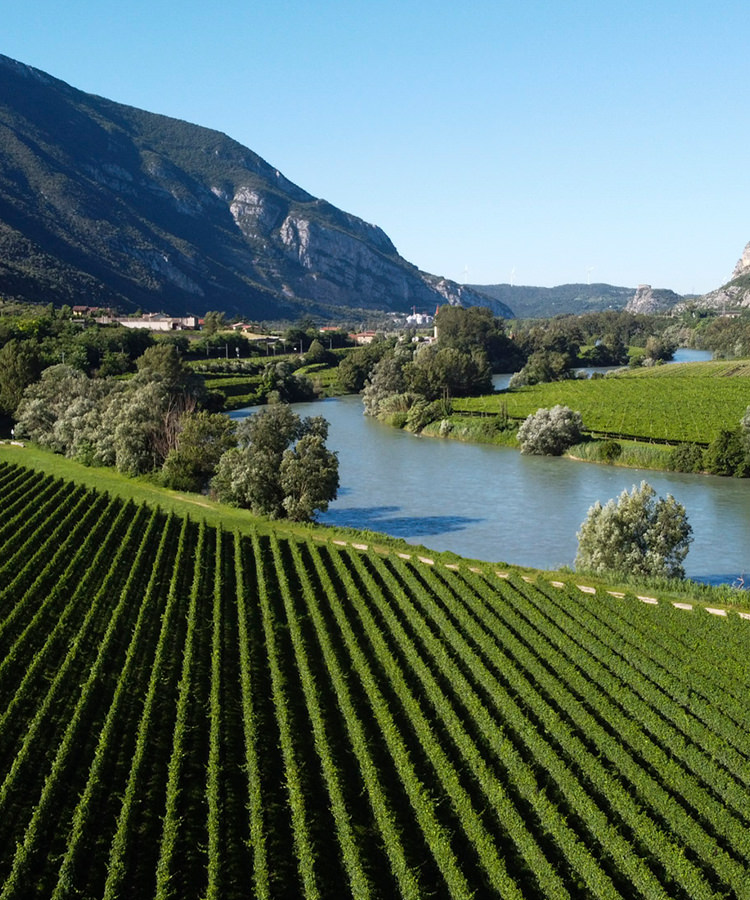
Crisp, refreshing, and perfect for year-round dining –– there’s a reason why some say Pinot Grigio transformed the concept of Italian white wines in the world. A delicate grape of French origin, Pinot Grigio thrives in the Triveneto area, a trio of regions in northeastern Italy that encompass the Veneto, Friuli Venezia Giulia, and Trentino.
Encompassing the soaring Dolomites, Lake Garda, the Venetian Lagoon, and the verdant hills of Collio, the Triveneto’s unique geography has formed rich microclimates with a diversity of terroirs ideal for growing Pinot Grigio. First cultivated around 500 BCE, the region now boasts a storied history as a producer of white wines and has passed down prized viticulture techniques for centuries.
Albino Armani, one of the oldest estates consistently producing wines in the area, was officially established in 1607 when it began by perfecting traditional techniques, and later gained recognition for also embracing new and innovative methods. Today, a commitment to sustainability remains vital to Albino Armani, which prioritizes paying critical attention to proper water management, and forgoing the use of artificial pesticides and chemicals. Helmed with these practices, the brand offers a Pinot Grigio for every occasion and taste profile, from celebratory toasts to sumptuous affairs.
Since creating the Albino Armani label, the family has sought to produce wines at altitudes that hug the mountains. Graced with cool climates, and vineyards surrounding the wineries, grapes can therefore quickly be sent for processing after harvest, which ensures freshness. Today, Albino Armani boasts five wineries throughout Friuli, Veneto, and Trentino, all overseen by Albino Armani, his wife, Egle, and their son, Federico, and their teams.

The first vineyard is in Dolcè, in the Adige Valley in southern Trentino, which is bordered by the mountains and the Adige River. These vines inhabit the slopes of Monte Baldo and the Lessini Mountain Range where limestone soil makes the land ideal for cultivating Chardonnay, Gewürztraminer, and, of course, Pinot Grigio. The grapes are grown according to the traditional pergola system on land that slopes toward the river, in soils that vary from morainic to alluvial. The area’s strong diurnal temperature variation also plays a critical role in the growth of the Pinot Grigio grape, which thrives in sunny, dry, and windy areas. That said, the Dolcé winery’s mountain location also makes it possible to produce the renowned local Valdadige DOC appellation. With its delicate, floral aromas and notes of fruit, mineral, and spices, Pinot Grigio Valdadige DOC pairs perfectly with shrimp and light seafood dishes, pasta, or summer salads, or can simply be enjoyed as an aperitif. Dolce’s Pinot Grigio “Corvara” Valdadige DOC is a single-estate wine and a signature offering for the winery. After the harvest, grapes are ushered through a drying process that heightens concentration and adds structure, leaving behind notes of stone fruit and white flowers. At Dolcè, Albino Armani also works to save traditional varieties from extinction, collaborating with research institutes on the Albino Armani Conservatory to monitor several on-premise rows of indigenous grapevines.
On the border between Trentino and Veneto stands a Napoleon-era fortress that has long watched over the valley. Its stoic vineyards produce the bold varietals behind the appellation Terredeiforti DOC. In accordance with traditional methods, Albino Armani’s Pinot Grigio “Colle Ara” DOC Terradeiforti is farmed on a limestone terroir to enhance the signature pink-gold color of Pinot Grigio. After harvest, a 24-hour cold-skin contact generates this subtle and enticing color. The final bottle contains notes of melon, wildflower, and berry, as well as valley herbs with a full, soft finish and beautiful acidity, leading it to be often hailed as “a Pinot Grigio for non-Pinot Grigio drinkers.”

A stunning alpine background frames the Armani family’s vineyards in Friuli Venezia Giulia. Here, Pinot Grigio Friuli Grave DOC is cultivated with a subtle tartness, high acidity, and minerality, with notes of vine fruit and citrus complementing the singular aromatic herbs found in Friuli whites. Here, Pinot Grigio pays tribute to the limestone toughness of the Friuli Grave territory.
Albino Armani also produces Pinot Grigio Delle Venezie DOC, the largest appellation in Italy, with crisp fruit notes highlighted by a light creaminess in this racy, sumptuous wine. The grapes used in this wine come from Albino Armani’s elite vineyards, located in the Triveneto.
In addition to benefiting from diverse ampelographic characteristics, Albino Armani’s Pinot Grigios are currently part of a very painstaking and particular project on indigenous yeasts undertaken together with a local research institute, where only the best strains are selected, tested, and ultimately chosen. This autochthonous heritage is reproduced at every harvest and used in the fermentation of all Albino Armani’s Pinot Grigios. Thus, the indigenous yeasts, which have long thrived in the vineyards’ climate conditions, continue to produce wines that embody the flavor profile of the territory.
For Albino Armani, Pinot Grigio not only represents the variety that contributed to the global success of Triveneto’s white wines but also acts as a flavorful “flag of its homeland that has elevated the region as well as fine dining experiences across the globe.” Today the name Albino Armani is inextricably linked to Pinot Grigio and to a new generation committed to preserving the grape’s historical importance –– and delicious taste.

This article is sponsored by Albino Armani.

